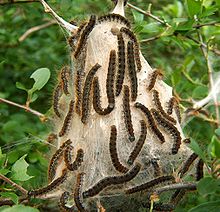Spring wool after
| Spring wool after | ||||||||||||
|---|---|---|---|---|---|---|---|---|---|---|---|---|

Spring wool juicer ( Eriogaster lanestris ) |
||||||||||||
| Systematics | ||||||||||||
|
||||||||||||
| Scientific name | ||||||||||||
| Eriogaster lanestris | ||||||||||||
| ( Linnaeus , 1758) |
The eriogaster lanestris ( Eriogaster lanestris ) is a butterfly ( moth ) from the family of clucking (Lasiocampidae).
features
The moths reach a wingspan of 30 to 35 millimeters. The basic color of the forewings is dark red-brown. At the base of the wing and near the middle of the wing there are two bright white spots, whereby the spot at the base of the wing is usually U-shaped or ring-shaped and somewhat larger than in the female. The rear third of the wing is separated by a white, slightly wavy and sometimes indistinct transverse line and is dusty white. The hind wings are also dark red-brown and have a white border. The females have an anal bush ("Wollafter") covered with thick, gray hair. Both sexes have a thick coat of gray-brown hair around the base of the wings, which spreads over the head, the base of the wing, and on the underside over the legs.
The caterpillars are about 45 millimeters long and are colored black. They have long, white hair, slightly reddish at the base, especially on the sides and occasionally on the back, and rust-red, short tufts of hair arranged in pairs on both sides of the back. Sometimes they have yellowish white spots or elongated spots on the sides.
Similar species
- Alpine wool after ( Eriogaster arbusculae )
- Hedge wool juicer ( Eriogaster catax )
Occurrence
The nocturnal animals occur in almost all of Europe except in the far north and parts of the Mediterranean area. In the east, they are distributed as far as the Amur . They live on the edge of the forest and in bushy terrain, but also in avenues and parks. They were widespread throughout Central Europe , but have now disappeared and endangered in many places.
Way of life
Flight and caterpillar times
The moths fly in one generation from mid-March to mid-April, depending on the temperature. The caterpillars are found from May to July.
Food of the caterpillars
The caterpillars feed on various deciduous tree - and shrub species, especially of silver birch ( Betula pendula ) and blackthorn ( Prunus spinosa ), but also of mountain ash ( Sorbus aucuparia ), goat willow ( Salix caprea ) and Eingriffeligem Hawthorn ( Crataegus monogyna ).
development
The females lay their eggs along thin branches and cover them with the long hair of their anal bushes to protect them from predators. The caterpillars live together between May and June in a large, white web, which usually hangs like a sack from the plant. They eat in community and then withdraw to their homes. Only at the end of their development do they become loners. They pupate on the ground in a brown oval cocoon . What is striking about this are two symmetrical holes that serve as breathing openings. The moths hatch very early in the year after overwintering, but the animals also occasionally overwinter and then hatch after up to seven years.
swell
Individual evidence
- ↑ a b c d e Heiko Bellmann : The new cosmos butterfly guide. Butterflies, caterpillars and forage plants. Franckh-Kosmos, Stuttgart 2003, ISBN 3-440-09330-1 , pp. 70f.
- ↑ Hans-Josef Weidemann, Jochen Köhler: Moths. Weirdos and hawkers. Naturbuch-Verlag, Augsburg 1996, ISBN 3-89440-128-1 , p. 110f.
- ↑ Manfred Koch : We identify butterflies. Volume 2: Bears, Spinners, Swarmers and Drills in Germany. 2nd, expanded edition. Neumann, Radebeul / Berlin 1964, DNB 452481929 , p. 94f.



